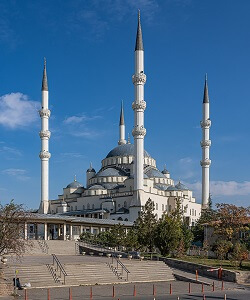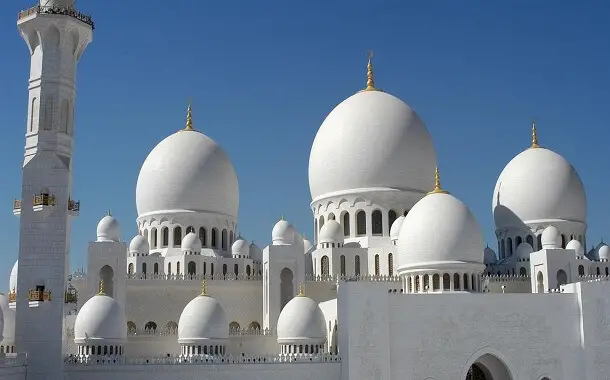Cost to Build a Mosque
From Indonesia to the United Kingdom, the mosque, in its many forms, is the main Islamic building. The mosque, masjid in Arabic, is the place where Muslims gather for prayer. Although most of the five daily prayers prescribed in Islam can take place anywhere, all men must gather at the mosque on Fridays for the noon prayer.
Mosques are also used during the week for prayer, study, or simply as a place for rest and reflection. The main mosque of a city, used for Friday communal prayer, is called jami masjid, literally “Friday Mosque”, but it is also called a congregational mosque.
How Much Does it Cost to Build a Mosque?
There are many factors that determine the final cost of building a mosque, including the style, location, and size of the mosque. You should expect to spend anywhere from $16,000 to several millions of dollars.
Around the world are organizations that collect money for building mosques, that in general start at approximately $14,000.
The most expensive mosque in the world is the Masjid Al-Haram, which is known as Grand Mosque. This has a size of 356,800 and is located in Mecca, Saudi Arabia. Its construction cost $100 billion.
How Much Does it Cost to Build a Mosque in the United States?
Again, depending on the building type, size, and location, the cost of building a mosque in the United States would be anywhere between $1.5 million and $3 million. Obviously, the costs will be higher in the areas of the country where the land is more expensive.
Regardless of whether these are houses, former churches, or commercial buildings, most mosques are made in bought buildings. But in the last twenty years, the number of mosques originally created to be a mosque has increased constantly.
In New York, the Islamic Cultural Center houses a mosque that was built in 1991 for $14 million. This has a minaret with a height of 130 feet and a main prayer hall that can accommodate one thousand people.
In Indiana, Fort Wayne, the construction of a mosque was started in 2010 with an estimated budget of $1.1 million. The building would include a main prayer space, various community outreach resources, and classrooms.
Though, most mosques are located in office buildings, plazas, shopping centers, and other places like these. Moreover, according to a New York Times article, in Angers, France a former slaughterhouse is used as a mosque. This place is used every week by almost 1,500 people.
How Much Does it Cost to Build a Mosque in Asia?
In general, the cost of building a small mosque in Asia is anywhere between $10,000 and $16,000.
Depending on the specific location and the square footage, the cost of building a larger mosque with a library and classrooms would be anywhere between $19,000 and $22,000, or even more. It will cost more than $81,000 to build a large central mosque.
| Mosque Size | Capacity | Cost Estimate |
|---|---|---|
| Small | 100 | $14,000 – $20,000 |
| Medium | 250 | $30,000 – $40,000 |
| Large | 400 | $45,000 – $65,000 |
| Central/Community | 600 | $85,000 – $125,000 |
How Much Does it Cost to Build a Mosque in Africa?
The cost of building a small mosque in Africa is much lower. Usually, it costs anywhere between $11,000 and $16,000, depending on the features of the mosque, its size, and the specific location. Plan on spending around $22,000 for building a larger mosque in Africa.
The costs for building a mosque in rural areas are lower while building in a middle-class or more developed area will cost you more. Expect to spend anywhere between $71,000 and $122,000 or even more for building a mosque, that can accommodate around one hundred worshipers, in a high-end community.
You might also like our article on the cost of a trip to Mecca.
Similar to any other building, the overall costs for building a mosque will vary depending on the labor costs in the specific community or town, and the cost of materials, features, design, and size of the mosque.
Crowdfunding for mosque building
All over the world, there are many organizations that collect contributions and donations necessary for building mosques. Most of the funds go to the building of mosques in areas of need, such as Asia and Africa.
Many Muslims are reluctant to use financing to refurbish or buy a mosque and oppose the idea of taking on an interest-bearing loan. So, the Islamic community usually looks inward for funding this type of project.
Common characteristics of a mosque
The main architectural components of a mosque are practical in purpose and provide both continuity and a sense of tradition among Muslims around the world.
Looking through photos of mosques around the world, there is a lot of variation. Building materials and design depend on the culture, heritage, and resources of each local Muslim community. However, there are some features that almost all mosques have in common, as described here.
Minaret (tower)
A minaret is a thin tower that is a traditional distinctive feature of a mosque, although they vary in height, style, and number. Minarets can be square, round, or octagonal and are usually covered with a pointed roof. They were originally used as a vantage point from which to call for prayer (adhan).
Sahn (inner courtyard)
The fundamental architectural requirement of a congregational mosque is its capacity to accommodate the entire male population of a town or village (women may attend Friday prayers but are not required to). For this, congregational mosques must contain a spacious prayer hall. In many mosques, it adjoins an open inner courtyard, called a sahn. A fountain is usually found in this courtyard, a welcome respite in hot lands and important for ablution (ritual washing) before prayer.
Mihrab (niche)
The mihrab is an ornamental, semi-circular indentation in the wall of a mosque’s prayer room that marks the direction of the qiblah—the direction toward Mecca that Muslims face during prayer. Mihrabes vary in size and color but are usually door-shaped and decorated with mosaic tiles and calligraphy to make the space stand out.
Qubba (dome)
Many mosques are decorated with a domed roof, especially in the Middle East. This architectural element has no spiritual or symbolic meaning and is purely aesthetic. The interior of a dome is usually highly decorated with floral, geometric, and other designs. The main dome of a mosque usually covers the main prayer hall of the structure, and some mosques may also have secondary domes.
Minbar
Minbar is a raised platform in the front area of a prayer hall in a mosque, from which sermons or speeches are given. Minbar is usually made of carved wood, stone, or brick. It includes a short staircase leading to the upper platform, which is sometimes covered by a small dome.
Musalla (place of prayer)
Inside, the central area for prayer is called the musalla (literally, “place of prayer”). It is deliberately left quite blank. No furniture is needed as worshipers sit, kneel and bow directly on the floor. There may be a few chairs or benches to assist worshipers or disabled people who have mobility difficulties.
On the walls and pillars of the prayer hall there are usually shelves to hold copies of the Qur’an, wooden books (rihal), other religious reading materials, and individual prayer rugs. Beyond this, the prayer hall is otherwise a wide, open space.
Décor
There are other decorative elements common to most mosques. For example, a large calligraphic frieze with a prominent inscription usually appears above the mihrab. In most cases, calligraphic inscriptions are quoted from the Qur’an and often include the date of construction of the building and the name of the builder.
Another important feature in the decoration of mosques is hanging lamps, also visible in the photo of Sultan Hassan Mosque. Light is an essential element for a mosque, since the first and last prayers of the day take place before sunrise and after sunset, respectively.
Before electricity, mosques were lit by oil lamps. Hundreds of such lamps hanging inside a mosque would have created an impressive spectacle, with light emanating from each, highlighting the calligraphy and other decorations on the surface of the lamps. Although they were not a permanent part of a mosque’s construction, lamps, along with other decorative elements such as carpets, gave a distinctive—albeit ephemeral—aspect to its architecture.
Challenges when building a mosque
 The process of building a mosque could be more difficult than you would expect due to the specific challenges that may appear.
The process of building a mosque could be more difficult than you would expect due to the specific challenges that may appear.
For instance, in the last ten years, local communities and municipalities opposed resistance when somebody tried to get permission to expand, move or build a mosque.
In other cases, the neighboring citizens complained about the added traffic, parking, and noise in the area.
It would be easier to build a mosque in states such as Florida, New York, Texas, and California because there you find the largest number of mosques in the United States. Also, most mosques are in large metropolitan areas like New York.
No matter what location you choose, you should be prepared to face court filings against the construction of a mosque. The battling with local municipalities and communities will add to the final costs.
Final words
The style, arrangement, and decorations of a mosque can tell us a lot about Islam in general, but also about the period and region in which the mosque was built.
Most historic mosques are not stand-alone buildings. Many of them incorporate charitable institutions such as social canteens, hospitals, or schools. Certain mosque builders choose to include their own mausoleum as part of the complex. This incorporation of charitable institutions is an important aspect of Islamic culture, especially because of the third pillar of Islam, which requires Muslims to donate a portion of their income to the poor.



Leave a Reply
Want to join the discussion?Feel free to contribute!